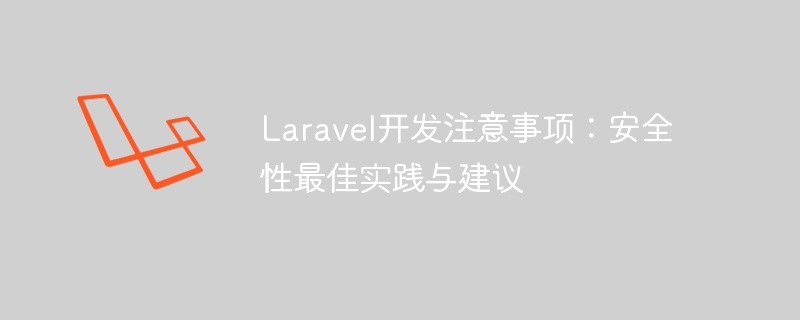

Laravel Development Notes: Security Best Practices and Recommendations
As network security threats continue to increase, security has become important in the web application development process Considerations. When developing applications using the Laravel framework, developers need to pay special attention to security issues to protect user data and applications from attacks. This article will introduce some security best practices and suggestions that need to be paid attention to in Laravel development to help developers effectively protect their applications.
SQL injection is a common way to attack web applications. Attackers insert malicious SQL statements into input boxes or URL parameters. to obtain or modify database contents. In Laravel development, you can use Eloquent ORM or Query Builder to build database query statements to prevent SQL injection attacks. Laravel's ORM and Query Builder will automatically bind parameters to the incoming data, thus avoiding the security risk of directly splicing SQL statements.
In addition, you also need to pay attention to the use of prepared statements and bound parameters to prevent malicious users from injecting malicious code.
Cross-site scripting attack is a common attack method. Attackers obtain malicious scripts by injecting them into web pages. users’ sensitive information or perform malicious operations. In Laravel development, using the Blade template engine can effectively prevent XSS attacks. The Blade template engine will automatically HTML escape the output content to prevent the injection of malicious scripts.
In addition, you can also use the @verbatim directive provided by Laravel to output a piece of text content as is to avoid the content being automatically escaped.
Cross-site request forgery is a common network attack method. The attacker initiates a forged request in the victim's browser to perform unauthorized operations. In Laravel development, CSRF tokens can be used to prevent cross-site request forgery attacks. The Laravel framework automatically generates a CSRF token for each form when processing POST, PUT, DELETE and other requests, and verifies the validity of the token when processing the request.
Developers need to ensure that the @csrf directive is included in all forms that require CSRF protection and verify the validity of the CSRF token on the backend.
In Laravel development, you can use the authentication and authorization functions provided by Laravel to manage user authentication and authorization. Developers need to ensure that a secure password hashing algorithm is used for password encryption when users log in. It is recommended to use Laravel's own Bcrypt hashing algorithm.
In addition, user permissions and roles need to be strictly controlled to prevent unauthorized users from performing sensitive operations. In Laravel, middleware and policies can be used to implement fine-grained permission control to ensure that users can only access resources for which they have permission.
In Laravel applications, special attention needs to be paid to the processing and storage of sensitive data. Developers need to properly design database table structures and field types, ensure that sensitive data is stored encrypted, and strictly control access permissions. In addition, attention must be paid to encrypting the transmission of sensitive data to avoid being stolen during network transmission.
Summary
The Laravel framework provides developers with a wealth of security features and tools that developers need to take full advantage of to protect the security of their applications. In addition to the security best practices and recommendations mentioned above, developers also need to keep an eye on security updates and vulnerability fixes for the Laravel framework and update applications in a timely manner to maintain security.
To sum up, security in Laravel development is a continuous process. Developers need to continuously learn and update security awareness, and take effective security measures to protect applications and user data. By following security best practices and recommendations, developers can effectively improve the security level of their applications and provide users with safe and reliable services.
The above is the detailed content of Laravel Development Notes: Security Best Practices and Recommendations. For more information, please follow other related articles on the PHP Chinese website!




